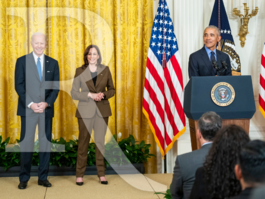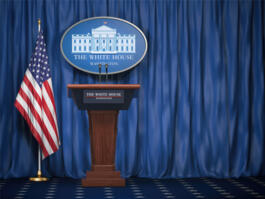Obama and Small Town America
A Commentary by Rhodes Cook
Barack Obama caused quite a stir a fortnight ago when he told a suburban San Francisco fund raiser that small-town Pennsylvania voters were "bitter" about their economic plight. As a consequence, he added, "they cling to guns or religion or antipathy to people who aren't like them..."
As political comments go, it was a self-inflicted "twofer". Not only was Obama's sociological analysis delivered in a place synonymous with permissive liberalism, but also it raised questions about the candidate's sensitivity to the lives of the hard-working, small-town voters that he was so intensively trying to woo.
Yet as controversial as they were, Obama's remarks basically have reflected the contours of his vote-getting appeal. By and large, he has succeeded thus far by rolling up the vote in urban areas with their large minority population, and penetrating populous white-collar suburbs and the growing exurbs beyond. Yet in many places where new subdivisions give way to countryside, the Obama vote noticeably begins to ebb. There, his only consistent support has come from the occasional oases of academe that dot the rural landscape.
Al Gore showed back in 2000 that a Democrat can narrowly win the fall popular vote with the cities and a fair chunk of the suburbs. Yet to win the electoral vote, their nominee needs to do a bit better. In short, the party has become quite expert at winning 48 percent of the vote, but it takes a special Democrat able to draw votes in small-town America to bring that extra 3 percent that would ensure victory. Quite possibly, Obama has the political skills to do it. But his tepid primary showings in rural parts of key battleground states such as Missouri, Ohio and Pennsylvania places the burden of proof on him to demonstrate that he can do it.
To be sure, Obama has run quite well in the rural areas of caucus states, where turnouts are low and his impassioned group of supporters can dominate. He also has run well in the rural portions of many Southern primary states from Louisiana to Virginia that boast a significant African-American population. And he has held his own in rural sectors of other primary states where a less partisan, even libertarian brand of politics is practiced, as in upper New England and many sparsely populated states west of the Mississippi River.
But as the Democratic primary campaign has moved into the key battleground states of the industrial Frost Belt, Obama has hit a brick wall in his bid for rural votes. In Missouri, Obama took only six of 116 counties (including the cities of St. Louis and Kansas City). In Ohio, he carried just five of 88; in Pennsylvania, only seven of 67.
Figure 1. Small-Town America: A Republican Cornerstone
Ever since the break up of the "Solid (Democratic) South" nearly a half century ago, small-town America has been a loyal element of the Republican presidential coalition. Democrats have found ways to come close to winning the presidency, based on rolling up the vote in the cities and penetrating deeper and deeper into the suburbs. But since 1968, only those Democratic nominees from the small-town South, Jimmy Carter and Bill Clinton, have actually been able to win the presidency.
|
Democratic Nominee |
Election Year |
Counties Won by Democrats |
Counties Won by Republicans |
Popular Vote Outcome |
|
Jimmy Carter |
1976 |
1,711 |
1,422 |
Won by 2% |
|
Bill Clinton |
1996 |
1,533 |
1,619 |
Won by 9% |
|
Bill Clinton |
1992 |
1,525 |
1,609 |
Won by 6% |
|
Jimmy Carter |
1980 |
904 |
2,229 |
Lost by 10% |
|
Michael Dukakis |
1988 |
820 |
2,319 |
Lost by 8% |
|
Hubert Humphrey |
1968 |
692 |
1,859 |
Lost by 0.7% |
|
Al Gore |
2000 |
674 |
2,478 |
Won by 0.5% (lost electoral vote) |
|
John Kerry |
2004 |
584 |
2,569 |
Lost by 3% |
|
Walter Mondale |
1984 |
332 |
2,807 |
Lost by 18% |
|
George McGovern |
1972 |
133 |
2,997 |
Lost by 23% |
Note: The county totals do not include those carried by independent or third-party presidential candidates in 1968 (George Wallace) and 1992 (Ross Perot). There are roughly 3,100 counties in the United States, including parishes in Louisiana and election districts in Alaska.
Source: Mapping the Political Landscape 2005 (Pew Research Center).
In Missouri, his votes were very well placed, enabling him to win the Democratic primary by a margin of barely 10,000 votes. He won the state's two major cities (St. Louis and KC), populous suburban St. Louis County, two counties in the center of the state that include the state capital of Jefferson City and the large academic community in Columbia (home of the University of Missouri), and one rural county in the northwest corner of the state. That was it. Hillary Clinton swept the rest of Missouri.
In Ohio, Obama's vote was even more contained. He carried only the urban counties that include Cleveland, Columbus, Cincinnati and Dayton, plus one county on the outskirts of Columbus. Not a single county in the broad swath of rural Ohio went his way, as he lost the primary to Clinton by 10 percentage points.
In Pennsylvania, the Clinton margin was similar and so was the political geography. Obama won big in Philadelphia, with its large African-American population, carried two of its four suburban counties, and took a pair of counties on the outer orbit of greater Philadelphia. The two other counties that he carried were in the center of the state, and each contained a major academic institution. As for the rest of Pennsylvania, it was essentially a vast wasteland for Obama.
One can only speculate as to why small-town Democrats in these states have so completely turned their backs on him. It could be pronounced racial attitudes; cultural differences with the liberal Obama; deep sentiment for the Clintons; horror at the sight of his poor bowling skills. Whatever it is, rural resistance to Obama seems particularly strong in these states that are so critically important to the Democrats come November.
Yet Obama's problems are not new for the modern Democratic Party. Rarely in recent years has it nominated a candidate with much small-town appeal. Since the current primary-dominated era of presidential politics began almost 40 years ago, the Democrats have selected only one candidate capable of winning a majority of the nation's 3,100 or so counties -- Jimmy Carter in 1976. And only one other Democratic nominee since then has even come close to carrying a majority of counties, Bill Clinton in 1992 and 1996.
Their common denominators: Both hailed from small towns in the South with the simplest of names, Plains and Hope; both served as governors of their states before running for president. And not coincidentally, they were the only two Democrats to have won the White House since 1968. Winning the cities and many of the suburbs can get Democrats close to the Oval Office. But only the candidates who can show appeal in rural America have had the key to open the door.
"Jimmy" and "Bubba" brought an understanding of small-town America to their campaigns that transcended their regional roots. They were able to win hundreds of rural counties across the country that Democratic presidential candidates normally do not carry, enabling each to mount winning presidential campaigns that included key battleground states such as Missouri, Ohio and Pennsylvania.
The challenge for Obama, and indeed for Hillary Clinton as well if she is the nominee, is to find a way to relate to these "God and guns" voters. It won't be easy for the former, a longtime resident of Chicago, or for the latter, a product of the nation's burgeoning suburbs. But for either, it could be the key to winning the White House this fall.
See Other Commentary by Rhodes Cook
See Other Political Commentary
Views expressed in this column are those of the author, not those of Rasmussen Reports.
Rasmussen Reports is a media company specializing in the collection, publication and distribution of public opinion information.
We conduct public opinion polls on a variety of topics to inform our audience on events in the news and other topics of interest. To ensure editorial control and independence, we pay for the polls ourselves and generate revenue through the sale of subscriptions, sponsorships, and advertising. Nightly polling on politics, business and lifestyle topics provides the content to update the Rasmussen Reports web site many times each day. If it's in the news, it's in our polls. Additionally, the data drives a daily update newsletter and various media outlets across the country.
Some information, including the Rasmussen Reports daily Presidential Tracking Poll and commentaries are available for free to the general public. Subscriptions are available for $4.95 a month or 34.95 a year that provide subscribers with exclusive access to more than 20 stories per week on upcoming elections, consumer confidence, and issues that affect us all. For those who are really into the numbers, Platinum Members can review demographic crosstabs and a full history of our data.
To learn more about our methodology, click here.



